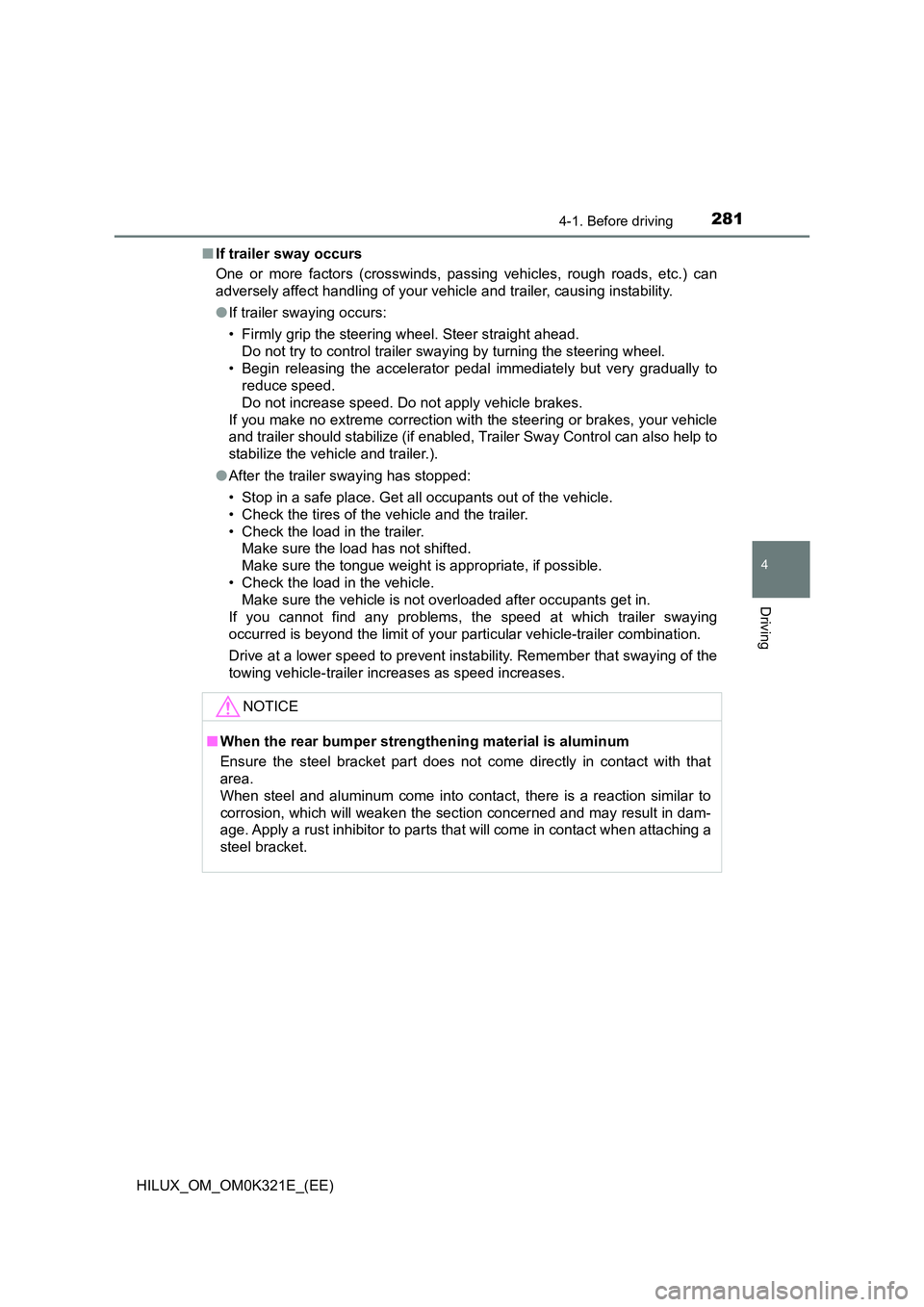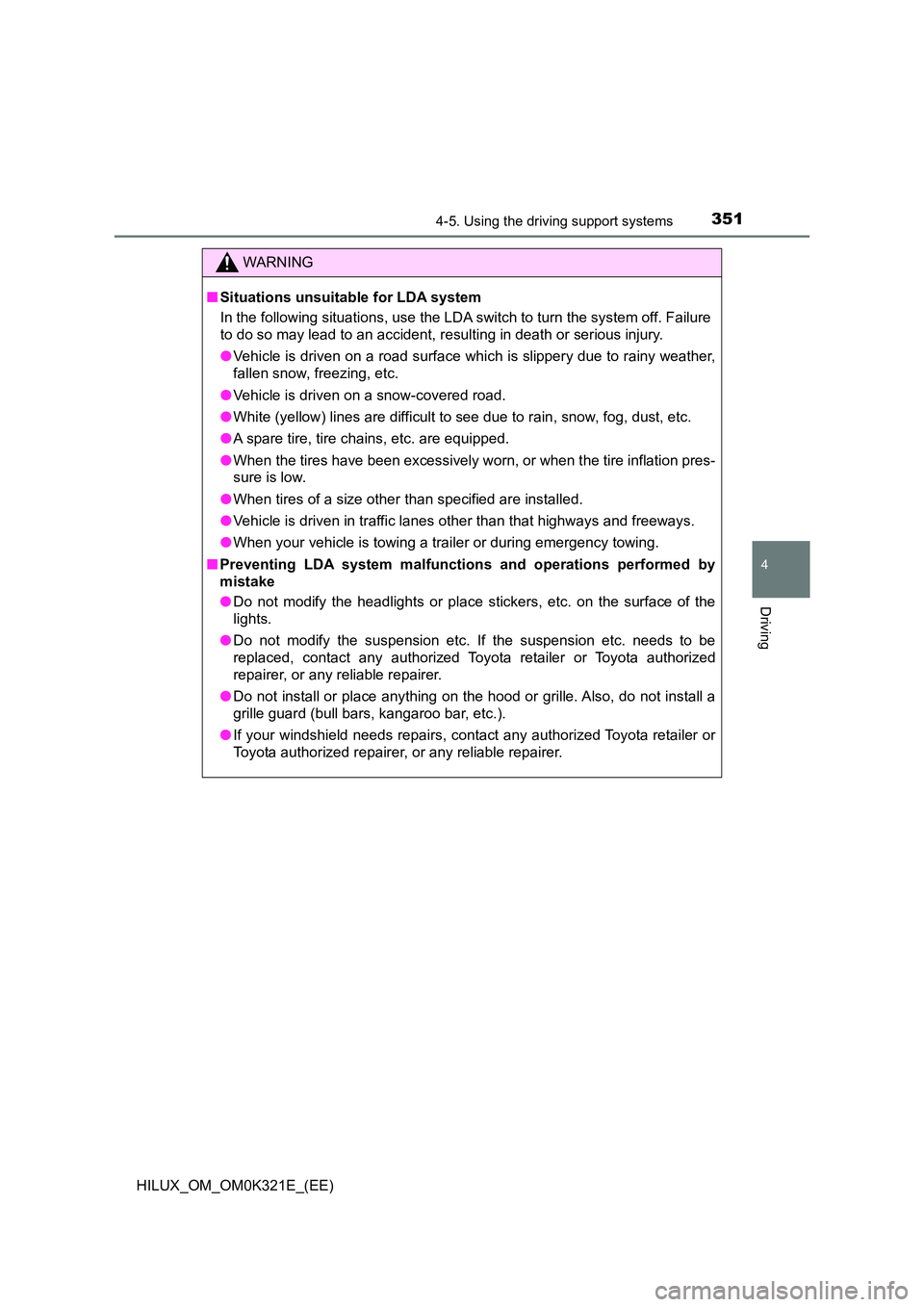Page 281 of 744

2814-1. Before driving
4
Driving
HILUX_OM_OM0K321E_(EE)
■ If trailer sway occurs
One or more factors (crosswinds, passing vehicles, rough roads, etc.) can
adversely affect handling of your vehicle and trailer, causing instability.
● If trailer swaying occurs:
• Firmly grip the steering wheel. Steer straight ahead.
Do not try to control trailer swaying by turning the steering wheel.
• Begin releasing the accelerator pedal immediately but very gradually to
reduce speed.
Do not increase speed. Do not apply vehicle brakes.
If you make no extreme correction with the steering or brakes, your vehicle
and trailer should stabilize (if enabled, Trailer Sway Control can also help to
stabilize the vehicle and trailer.).
● After the trailer swaying has stopped:
• Stop in a safe place. Get all occupants out of the vehicle.
• Check the tires of the vehicle and the trailer.
• Check the load in the trailer.
Make sure the load has not shifted.
Make sure the tongue weight is appropriate, if possible.
• Check the load in the vehicle.
Make sure the vehicle is not overloaded after occupants get in.
If you cannot find any problems, the speed at which trailer swaying
occurred is beyond the limit of your particular vehicle-trailer combination.
Drive at a lower speed to prevent instability. Remember that swaying of the
towing vehicle-trailer increases as speed increases.
NOTICE
■ When the rear bumper strengthening material is aluminum
Ensure the steel bracket part does not come directly in contact with that
area.
When steel and aluminum come into contact, there is a reaction similar to
corrosion, which will weaken the section concerned and may result in dam-
age. Apply a rust inhibitor to parts that will come in contact when attaching a
steel bracket.
Page 299 of 744

2994-2. Driving procedures
4
Driving
HILUX_OM_OM0K321E_(EE)
■ Transmission protection function
If the tires spin continually when the vehicle becomes stuck in mud, dirt or
snow, or if the accelerator pedal is depressed and released repeatedly while
driving, the automatic transmission temperature may become too high and
the automatic transmission may be damaged.
To avoid damaging the automatic transmission, the system may temporarily
lock the gear.
If the automatic transmission temperature falls, the gear locking is canceled
and the automatic transmission is returned to the normal operation.
■ If the warning message is displayed
When the warning message goes out, the vehicle can be driven again.
If the warning message does not go out after waiting a while, have your vehi-
cle inspected by any authorized Toyota retailer or Toyota authorized repairer,
or any reliable repairer.
■ AI-SHIFT
The AI-SHIFT automatically selects the suitable gear according to driver per-
formance and driving conditions.
The AI-SHIFT automatically operates when the shift lever is in D. (Shifting the
shift lever to S cancels the function.)
If the automatic transmission fluid tem-
perature warning message is displayed
while driving, make sure to return to D
position driving and reduce speed by eas-
ing off the accelerator pedal. Stop the
vehicle in a safe place, shift the shift lever
to P and let the engine idle until the warn-
ing message goes out.
WARNING
■ When driving on slippery road surfaces
Do not accelerate or shift gears suddenly.
Sudden changes in engine braking may cause the vehicle to spin or skid,
resulting in an accident.
■ To prevent an accident when releasing the shift lock
Before pressing the shift lock override button, make sure to set the parking
brake and depress the brake pedal.
If the accelerator pedal is accidentally depressed instead of the brake pedal
when the shift lock override button is pressed and the shift lever is shifted
out of P, the vehicle may suddenly start, possibly leading to an accident
resulting in death or serious injury.
Page 302 of 744

3024-2. Driving procedures
HILUX_OM_OM0K321E_(EE)
■Maximum downshifting speeds
Observe the downshifting speeds in the following table to prevent over-rev-
ving the engine.
5-speed transmission
4WD models (front-wheel drive control switch in H2 or H4):
km/h (mph)
*1: TGN126L-DTMSK models*3
*2: TGN126L-DTMLK models*3
*3: See “Checking your vehicle’s model” if you are not sure of which model
your vehicle is. ( P. 12)
4WD models (front-wheel drive control switch in L4):
km/h (mph)
*1: TGN126L-DTMSK models*3
*2: TGN126L-DTMLK models*3
*3: See “Checking your vehicle’s model” if you are not sure of which model
your vehicle is. ( P. 12)
Maximum speed
Shift position1234
225/70R17C tires38 (23)71 (44)114 (70)164 (101)
265/65R17 tires39 (24)72 (44)117 (72)168 (104)
205R16C tires39 (24)*1
37 (22)*273 (45)*1
69 (42)*2118 (73)*1
112 (69)*2170 (105)*1
160 (99)*2
Maximum speed
Shift position1234
225/70R17C tires15 (9)28 (17)45 (27)64 (39)
265/65R17 tires15 (9)28 (17)46 (28)65 (40)
205R16C tires15 (9)28 (17)*1
27 (16)*246 (28)*1
44 (27)*266 (41)*1
63 (39)*2
Page 303 of 744
3034-2. Driving procedures
4
Driving
HILUX_OM_OM0K321E_(EE)
6-speed transmission
4WD models (front-wheel drive control switch in H2 or H4):
km/h (mph)
Maximum speed
Shift position12345
205R16C tires34 (21)67 (41)113
(70)
163
(101)
170
(105)
225/70R17C tires35 (21)69 (42)116
(72)
167
(103)
170
(105)
265/65R17, 265/60R18
tires36 (22)70 (43)118
(73)
170
(105)
170
(105)
Page 304 of 744
3044-2. Driving procedures
HILUX_OM_OM0K321E_(EE)
4WD models (front-wheel drive control switch in L4):
km/h (mph)
Pre Runner:
km/h (mph)
Maximum speed
Shift position 1 2 3 4 5
205R16C tires13 (8)26 (16)44 (27)64 (39)82 (50)
225/70R17C tires14 (8)27 (16)45 (27)65 (40)84 (52)
265/65R17 tires14 (8)27 (16)46 (28)67 (41)86 (53)
265/60R18 tires14 (8)28 (17)46 (28)67 (41)86 (53)
Maximum speed
Shift position12345
225/70R17C tires35 (21)69 (42)116
(72)
167
(103)
175
(108)
265/60R18 tires36 (22)70 (43)118
(73)
171
(106)
175
(108)
265/65R17 tires36 (22)70 (43)118
(73)
170
(105)
175
(108)
Page 342 of 744

3424-5. Using the driving support systems
HILUX_OM_OM0K321E_(EE)
WARNING
■When to disable the pre-collision system
In the following situations, disable the system, as it may not operate prop-
erly, possibly leading to an accident resulting in death or serious injury:
● When the vehicle is being towed
● When your vehicle is towing another vehicle
● When transporting the vehicle via truck, boat, train or similar means of
transportation
● When the vehicle is raised on a lift with the engine running and the tires
are allowed to rotate freely
● When inspecting the vehicle using a drum tester such as a chassis
dynamometer or speedometer tester , or when using an on vehicle wheel
balancer
● When a strong impact is applied to the front bumper or front grille, due to
an accident or other reasons
● If the vehicle cannot be driven in a stable manner, such as when the vehi-
cle has been in an accident or is malfunctioning
● When the vehicle is driven in a sporty manner or off-road
● When the tires are not properly inflated
● When the tires are very worn
● When tires of a size other than specified are installed
● When tire chains are installed
● When a compact spare tire or an emergency tire puncture repair kit is used
● If equipment (snow plow, etc.) that may obstruct the radar sensor or front
camera is temporarily installed to the vehicle
Page 349 of 744

3494-5. Using the driving support systems
4
Driving
HILUX_OM_OM0K321E_(EE)
• If the wheels are misaligned
• If a wiper blade is blocking the front camera
• The vehicle is being driven at extremely high speeds
• When driving on a hill
• If the radar sensor or front camera is misaligned
● In some situations such as the following, sufficient braking force may not be
obtained, preventing the system from performing properly:
• If the braking functions cannot operate to their full extent, such as when
the brake parts are extremely cold, extremely hot, or wet
• If the vehicle is not properly maintained (brakes or tires are excessively
worn, improper tire inflation pressure, etc.)
• When the vehicle is being driven on a gravel road or other slippery sur-
face
■ If VSC is disabled
● If VSC is disabled (P. 425), the pre-collision brake assist and pre-collision
braking functions are also disabled.
● The PCS warning light will turn on and “VSC Turned Off Pre-Collision Brake
System Unavailable” will be displayed on the multi-information display.
• If the front of the vehicle is raised or
lowered
Page 351 of 744

3514-5. Using the driving support systems
4
Driving
HILUX_OM_OM0K321E_(EE)
WARNING
■Situations unsuitable for LDA system
In the following situations, use the LDA switch to turn the system off. Failure
to do so may lead to an accident, resulting in death or serious injury.
● Vehicle is driven on a road surface which is slippery due to rainy weather,
fallen snow, freezing, etc.
● Vehicle is driven on a snow-covered road.
● White (yellow) lines are difficult to see due to rain, snow, fog, dust, etc.
● A spare tire, tire chains, etc. are equipped.
● When the tires have been excessively worn, or when the tire inflation pres-
sure is low.
● When tires of a size other than specified are installed.
● Vehicle is driven in traffic lanes other than that highways and freeways.
● When your vehicle is towing a trailer or during emergency towing.
■ Preventing LDA system malfunctions and operations performed by
mistake
● Do not modify the headlights or place stickers, etc. on the surface of the
lights.
● Do not modify the suspension etc. If the suspension etc. needs to be
replaced, contact any authorized Toyota retailer or Toyota authorized
repairer, or any reliable repairer.
● Do not install or place anything on the hood or grille. Also, do not install a
grille guard (bull bars, kangaroo bar, etc.).
● If your windshield needs repairs, contact any authorized Toyota retailer or
Toyota authorized repairer, or any reliable repairer.